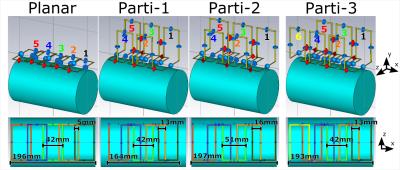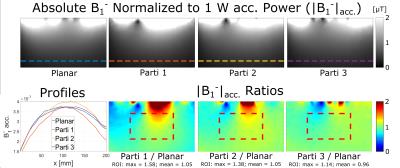2705
Exploring New Possibilities in Array Design using Partially Orthogonal RF Resonators (Parti-Coils): A Numerical Simulation Study at 3 Tesla1Computer Assisted Clinical Medicine, Medical Faculty Mannheim, Heidelberg University, Mannheim, Germany
Synopsis
Partially orthogonal RF resonators (Parti-coils) is a novel concept in which RF coils are extended in an orthogonal direction. This increases overlap distance between elements. Therefore, coil density can be optimized. We show alternative geometrical coil configurations in array design using Parti-coils and compare them to an array of traditional planar coils using numerical simulations. Parti-coils enhanced the flexibility in array design, increased the overlap distance between coils by a maximum 3.2-fold, decreased next-nearest neighbor coupling by more than 6dB, showed up to 6.6% higher |B1-|acc. penetration depth, and a factor 1.05 increase of |B1-|acc. at a ROI.
Purpose
In coil array design, coil density, overlap and, therefore, the total area of the array are fixed parameters determined by the individual element sizes. This limits the design and presents the problem of coupling between next-nearest neighbors. Preamplifier decoupling is used to mitigate this problem but it was proved irrelevant for SNR performance1.
Partially orthogonal RF resonators2 (Parti-coils) is a novel concept in which an orthogonal component is added to the RF coils. This adds a degree of freedom to the array design. The purpose of this study is to show alternative geometrical coil configurations in an array design using Parti-coils. Furthermore, we implement an alternative method to decrease next-nearest neighbor coupling and compare the performance of three arrays of Parti-coils and a configuration of traditional planar elements using EM simulations.
Methods
Five planar coils with dimensions 80x42mm² were modeled as a linear array with overlap decoupling. Parti-coils were modeled by increasing the area of the coils in an orthogonal direction along the longer axis of the coils in opposite sides of overlapped coils. A 1mm distance in z-axis was added to these opposite elements to avoid contact between elements. The dimensions of the orthogonal area and planar area were equal to maintain coil balance. Three different designs were explored using Parti-coils. In Parti-1, the planar dimensions were maintained to investigate the distance for overlap decoupling. In Parti-2, the width of the coils was increased to occupy a similar area as the planar array. In Parti-3, the planar dimensions were maintained and an additional element was added. Capacitors were added to the orthogonal areas between next-nearest neighbor elements to mitigate coupling3. In all arrays, the nearest distance of the elements from a cylindrical phantom (ε = 80, σ = 0.91S/m, radius = 57.5mm and length = 200mm) was 10mm. Overlapped elements had an additional separation of 3mm in the y-axis (See Fig. 1). FEM simulations were performed in CST Microwave Studio (CST, Darmstadt, Germany) with tetrahedral mesh and zero phase. Combined B1- fields were normalized to 1W accepted power (B1-acc.). Fields inside the phantom in a 2D transversal slice going through the center (z=0) were post-processed in MATLAB (The Mathworks, Natick, USA). Arrays were compared concerning coupling between elements using S-parameters and performance using |B1-|acc. Specifically, penetration depth was evaluated in profiles along the x-axis taken at a depth of 100mm inside the phantom. Finally, the |B1-|acc. yielded by the arrays was evaluated in a ROI of half the 2D slice.Results
In Parti-1, a 16% reduction in the array’s length was yielded compared to the planar array due to the orthogonal area. In Parti-2 and Parti-3, the difference was purposely maintained to millimeter range. A greater impact was observed in the overlap distances which increased in a 2.6-fold (Parti-1 and Parti-3) and a 3.2-fold (Parti-2). Distances to the next-nearest neighbor decreased to 10mm for Parti-1 and Parti-3 and to 13mm for Parti-2 (see Fig. 1).
The S-parameters showed an overall decrease of more than 6dB in coupling of next-nearest neighbors due to the capacitors interconnected in all Parti-coils. Moreover, the number of coils pairs with S-parameters greater than -10dB was reduced from 3 to 2 for the same number of elements as the planar array (see Fig. 2).
The |B1-|acc. profiles yielded a 6.6% higher maximum penetration depth for Parti-2 (398.1nT) compared to the planar array and Parti-3 (373.5nT each). A similar (ca. 1% decrease) peak |B1-|acc. was yielded by the narrower profile of Parti-1 compared to the planar array. At the ROI, Parti-1 and Parti-2 showed mean gains of 1.05-fold in contrast to Parti-3 which showed a 0.96 ratio compared to the planar array (see Fig. 3).
Discussion
The presented Parti-coils modified the possible arrangement of elements in a coil array which was used to reduce coupling between next-nearest neighbors, increase coil density, and enhance the performance of the array. This study is presented as proof-of-principle and the Parti-coils were not extended in the z-axis which could be achieved with a combination of Parti and planar elements. Further considerations due to the orthogonal area include added complexity to the construction and placement in the bore. However, the increased performance and reduction of coupling could be highly beneficial for SNR. The increased coil density should be explored for parallel imaging. Adapting and building Parti-Coils for specific applications is in the scope of our future work.Conclusion
Parti-coils enhanced the optimization of coil density in arrays and showed increased performance in comparison to an array of planar elements despite added coil material.Acknowledgements
No acknowledgement found.References
1. Reykowski A. et al. Do We Need Preamplifier Decoupling? In Proceedings of the 19th Annual Meeting of ISMRM, Montreal, Quebec, Canada, 2011. p. 3883.
2. Chacon-Caldera J. MRI-Antenna and Method For Providing MR-Images. Provisional Patent Pending. No. EP 16001855.2 - 1568, filed: 24/08/2016.
3. Wu B. et al. 7T Human Spine Imaging Arrays With Adjustable Inductive Decoupling. IEEE Trans. Biomed. Eng. 2010; 57(2):397–403.
Figures


